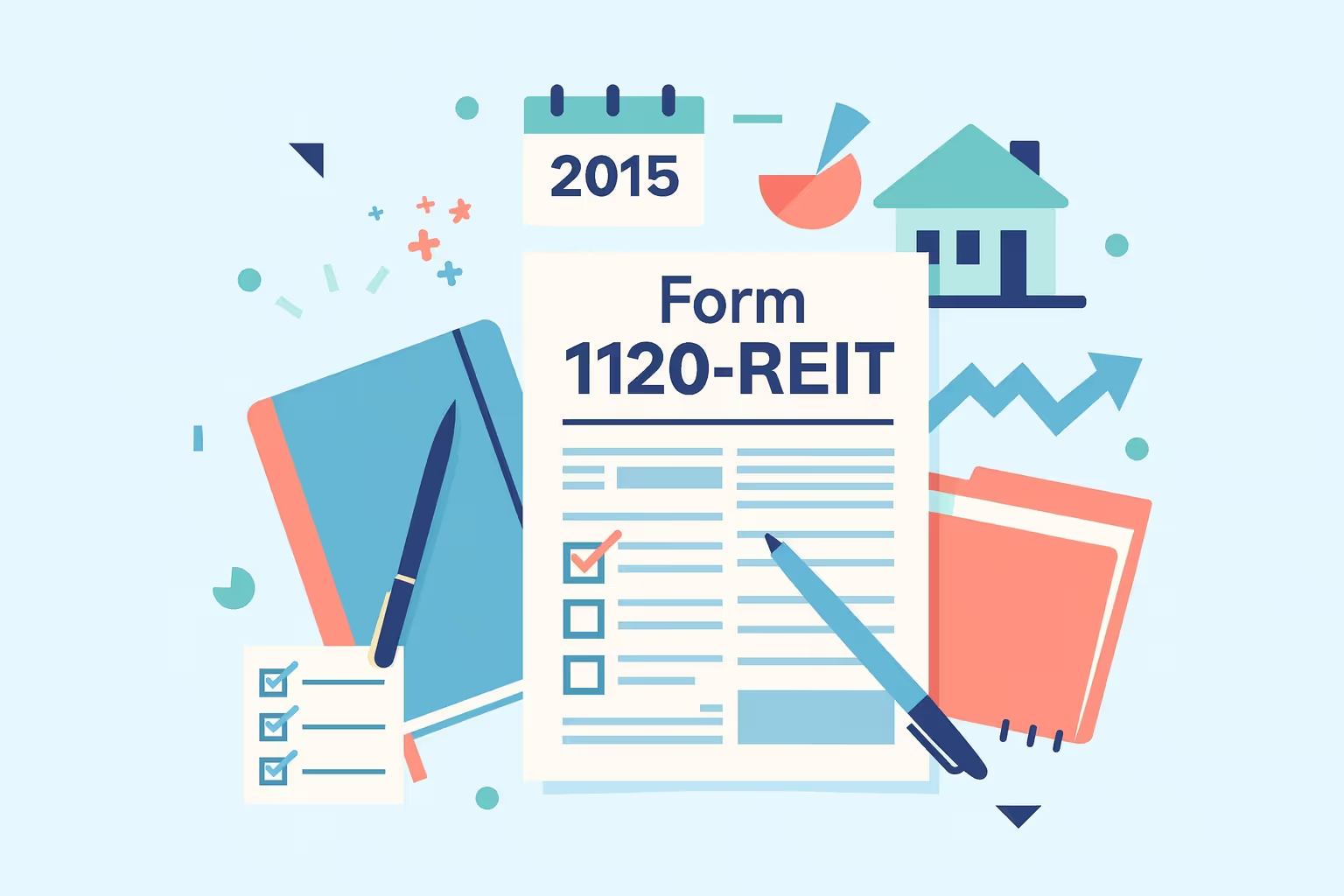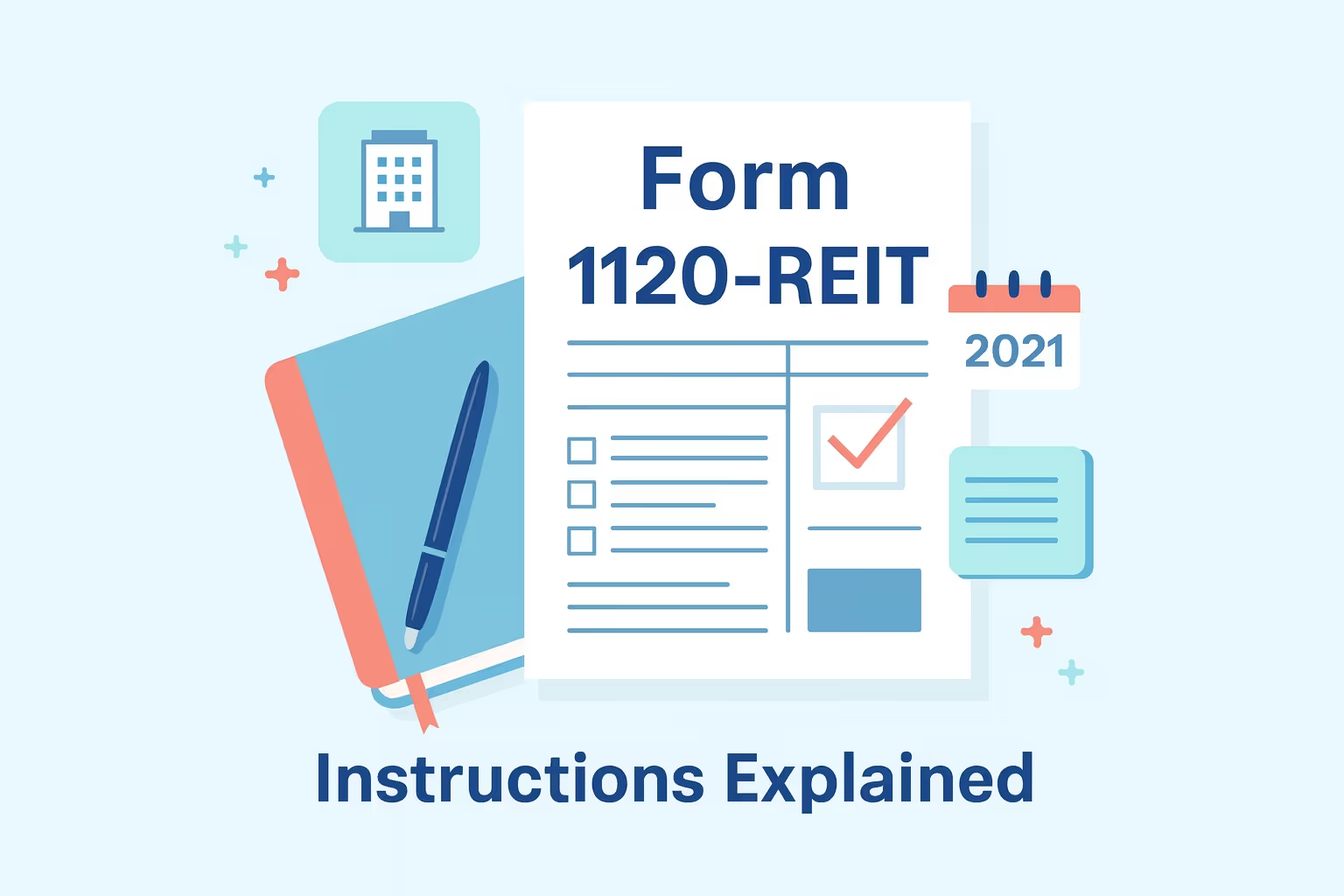
Filing Form 1120-REIT 2010 instructions is an essential step for Real Estate Investment Trusts that must meet federal tax obligations. This specialized income tax return ensures compliance with Internal Revenue Service regulations, helping real estate companies maintain their favorable tax status. Unlike standard corporate filings, this form is specifically designed for entities that own or finance income-producing real estate and distribute a substantial portion of their taxable income to shareholders.
The purpose of Form 1120-REIT is to calculate and report taxable income, deductions, credits, and capital gains generated during the tax year. By completing the return correctly, most REITs avoid corporate-level taxes and instead pass earnings directly to investors through dividends. This structure encourages investment in property and mortgages while providing tax advantages that would not otherwise be available to traditional corporations or financial institutions.
For many businesses operating as REITs, the filing process may seem complex at first. The form requires accurate reporting of income produced from various sources, along with proper documentation of distributions, assets, and expenses. Understanding how to file correctly helps prevent errors, penalties, or unnecessary costs. This guide provides clear step-by-step instructions, offering examples and practical explanations to help companies, shareholders, and investors navigate the process with confidence.
Overview of Form 1120-REIT
Form 1120-REIT is the federal income tax return that Real Estate Investment Trusts must file with the IRS. Its primary purpose is to report taxable income, deductions, credits, and capital gains so the government can assess income tax liability.
This form differs from Form 1120, which regular corporations file, as it is tailored for entities that own or finance income-producing real estate. Filing this report accurately enables REITs to maintain compliance and preserve their favorable tax treatment.
The purpose of the form includes
- The form is used to report taxable income and deductions, allowing the IRS to determine a REIT’s correct income tax liability for the year.
- It requires disclosure of credits, distributions, and gains that apply specifically to REITs rather than to corporations or S corporations.
- The report provides information to shareholders and investors, enabling them to understand the amount of income being distributed in the form of dividends.
Key benefits of REIT status are
- Most REITs avoid corporate-level taxation if they distribute at least 90% of their taxable income to shareholders, allowing earnings to flow directly to investors.
- REITs enable individuals, businesses, and financial institutions to purchase shares and indirectly invest in large-scale real estate projects without having to own or manage property directly.
- The structure provides investors with steady distributions while ensuring the company remains in compliance with federal tax regulations.
Components of Form 1120-REIT include
- The form’s core pages are used to calculate taxable income, deductions, credits, and overall income tax liability.
- Several schedules are attached to report dividends, balance sheet information, and adjustments that reconcile book income with taxable income.
- Other forms may also be required, such as depreciation schedules or excise tax filings, depending on the REIT’s financial activities during the year.
In summary, Form 1120-REIT provides a comprehensive framework for real estate companies to prepare their income tax returns in accordance with IRS requirements. By following the instructions carefully, REITs can report income produced from property, mortgages, and investments while remaining compliant and avoiding unnecessary penalties.
What’s New for Tax Year 2010
The 2010 tax year introduced updates that affected how Real Estate Investment Trusts reported their income tax return. While some changes took effect in later years, it was important for companies to prepare for these adjustments. Understanding these updates ensured accurate filing and helped prevent penalties or confusion when completing Form 1120-REIT.
Key updates for the 2010 filing period included
- Beginning January 1, 2011, REITs were required to use electronic funds transfers for all federal tax deposits. Paper deposit coupons, such as Forms 8109 and 8109-B, are no longer valid.
- REITs that began operations in 2010 were eligible to deduct up to $10,000 of start-up costs under section 195(b)(3), providing significant tax relief for newly established businesses.
- Certain REITs gained the option to increase their minimum tax credit limitation rather than claiming bonus depreciation for specific property placed in service after December 31, 2010.
These adjustments highlighted how regulations evolve. Even though not all changes applied directly to 2010, being aware of them helped REITs plan their future tax strategies more effectively.
Step-by-Step Filing Process
Filing Form 1120-REIT requires accuracy and attention to detail. Following a transparent process helps businesses meet IRS requirements while ensuring that taxable income and distributions are reported correctly.
Step 1: Gather required information.
- REITs should collect all income statements, including rents, dividends, interest, and partnership income, so that the IRS can verify sources of gross income.
- Companies must compile expense records, depreciation schedules, and documentation of property sales to calculate deductions accurately.
- It is also necessary to keep prior year income tax returns, IRS notices, and records of distributions to shareholders as part of the filing package.
Step 2: Complete header information.
- The REIT must enter its legal name, address, and Employer Identification Number exactly as registered to ensure proper identification.
- Checkboxes for subsidiaries, ownership details, or amendments must be marked carefully to avoid errors or processing delays.
Step 3: Identify REIT type.
- Filers should specify whether the entity is an equity REIT, which owns and operates property, or a mortgage REIT, which invests in mortgages and financial assets.
Step 4: Report income and deductions.
- For the IRS to assess total earnings, gross income—which includes rents, dividends, interest, and gains from property sales—should be reported in its entirety.
- Deductions must be subtracted, including salaries, interest expenses, depreciation, and other allowable costs, to determine the correct taxable income.
Step 5: Calculate taxable income.
- Taxable income is calculated by applying adjustments for capital gains, credits, and distributions to shareholders.
- The final income tax liability must be confirmed, and the completed report should be reviewed to ensure accuracy before submission.
Step 6: Attach schedules and other forms.
- Required schedules such as Schedule A (Dividends Paid) and Schedule J (Tax Computation) must be attached to provide detailed calculations.
- Additional schedules, such as Schedule K, Schedule M-1, and Schedule M-2, along with other forms for depreciation or excise taxes, must also be included where applicable.
By completing these steps carefully and in order, a REIT can file its return accurately, avoid penalties, and maintain compliance with IRS regulations.
Filing Methods and Deadlines
Form 1120-REIT may be filed either on paper or electronically, and the filing method chosen depends on the REIT’s size and preferences. Regardless of method, REITs must meet IRS deadlines to avoid penalties and interest.
Filing locations
- REITs with less than $10 million in assets, based in particular in eastern and midwestern states, should file their income tax return with the IRS Service Center in Cincinnati, Ohio.
- REITs with $10 million or more in assets, as well as those located in other regions, should send their returns to the IRS Service Center in Ogden, Utah.
Paper filing requirements
- Paper returns must be assembled in the order specified by the IRS, with schedules and other forms placed behind the main form. This ensures that all information is organized for efficient review and analysis.
- Certified mail should be used when filing by paper, as it provides proof of delivery and protects the filer in the event of a notice of late submission.
Electronic filing options
- Electronic filing may be completed through IRS-approved tax software, authorized transmitters, or tax professionals who provide e-file services.
- Filing through the internet offers faster processing, reduces the likelihood of errors, and provides immediate confirmation of submission.
Deadlines
- The due date for the 2010 tax year was March 15, 2011, unless the REIT requested an extension using Form 7004.
- An extension only applied to the time allowed for filing the return; it did not extend the deadline to pay taxes owed.
Meeting these deadlines and selecting the appropriate filing method ensures that REITs remain compliant with IRS requirements and avoid failure-to-file penalties.
Payment Instructions
Every Real Estate Investment Trust must ensure that payments are made on time to meet IRS requirements. The payment process is straightforward, but it must be handled carefully to avoid penalties and interest charges.
Payment methods accepted by the IRS include
- A REIT may send a check or money order payable to the United States Treasury, including its Employer Identification Number and tax year on the memo line for proper credit.
- Companies can use electronic funds transfers through the Electronic Federal Tax Payment System, which is the IRS’s recommended method for secure and timely payments.
- A REIT may pay by credit card using an IRS-approved third-party processor, although additional fees may apply.
Due date and penalties
- For calendar year 2010, all payments were due by March 15, 2011, which was the same day the return was required to be filed.
- Failure to pay by this deadline could result in penalties, including a failure-to-pay penalty calculated as a percentage of the unpaid taxes.
- Interest also accrues on unpaid balances, meaning the longer a REIT delays payment, the higher the total amount owed becomes.
By understanding the accepted payment methods and adhering to due dates, REITs can remain compliant and avoid unnecessary costs. Filing the return on time, even when unable to pay in full, reduces the risk of significant penalties.
Required Schedules and Attachments
Filing Form 1120-REIT involves more than just completing the main form. Several schedules and additional forms must be included to provide the IRS with a complete and accurate picture of the REIT’s financial activities.
Key schedules
- Schedule A must be used to calculate the deduction for dividends paid, which is typically the most critical deduction available to REITs.
- Schedule J determines the final tax liability by accounting for regular REIT tax, foreclosure property tax, prohibited transaction tax, and any applicable alternative minimum tax.
- Schedule K provides additional required information, including accounting methods, ownership details, and details of foreign transactions.
- Schedule L reports beginning and end-of-year balance sheets, while Schedule M-1 and Schedule M-2 reconcile book income and retained earnings with taxable income.
Other forms that may be required
- Form 4562 must be attached when claiming depreciation on property or other assets.
- Form 4797 is used to report the sale of business property not included in capital gains.
- Form 8612 may be required if the REIT owes excise tax on undistributed income.
Including these schedules and forms is essential for providing complete documentation. By submitting a correctly assembled return, a REIT demonstrates compliance, minimizes the chance of processing delays, and avoids notices for missing information.
Common Mistakes to Avoid
When filing Form 1120-REIT, REITs must take care to avoid errors that could lead to penalties, additional IRS notices, or even the loss of REIT status. Many mistakes occur due to oversight or misclassification of income and deductions.
Frequent filing errors
- Some REITs incorrectly combine prohibited transaction income with regular income, which should be reported separately in the proper section of the form.
- Filers often make mistakes when calculating the 90 percent distribution requirement, resulting in distributions that fail to meet the statutory criteria.
- Certain companies fail to attach mandatory schedules or other required forms, which can delay IRS processing and trigger notices for incomplete filings.
- REITs sometimes provide inadequate documentation for asset tests or fail to maintain records of quarterly compliance, which may raise qualification questions.
Avoiding these mistakes ensures smoother processing and compliance with IRS regulations. Careful preparation, thorough review, and proper documentation help REITs protect their tax-advantaged status and minimize the risk of unnecessary penalties.
Special Situations for REITs
Certain Real Estate Investment Trusts face unique filing circumstances that require extra attention. Even if a REIT has no significant activity during the year or is filing for the first time, it must still comply with IRS requirements.
Zero activity or dormant years
- Even in years when no income is earned, a REIT must still file Form 1120-REIT to maintain its election and remain in compliance with the IRS.
- The REIT should complete the header information, taxable income section, and balance sheet schedules, even if most entries show a zero balance.
- Filing during dormant years helps preserve the entity's status and ensures it can continue to operate as a REIT in future periods.
First-time filers
- A REIT preparing its first return should begin organizing records at least 90 days before the filing deadline, including property values, distributions, and expenses.
- If a company converted to REIT status during 2010, it may need to file Form 1120 for the pre-REIT portion of the year and Form 1120-REIT for the remainder of the year.
- Newly elected entities should establish robust filing practices, including consistent record-keeping and quarterly monitoring, to minimize errors in subsequent years.
Comparison to other structures
- Unlike an S corporation or regular corporation, a REIT must meet asset and income tests to qualify for special tax treatment.
- Filing as a REIT requires more detailed reporting of dividends, distributions, and shareholder information than other business structures.
By understanding these special situations, companies can prepare filings that reflect their current status while protecting their long-term ability to operate as REITs.
REIT Qualification Tests and Distribution Rules
Maintaining REIT status depends on strict compliance with several asset and income tests. Additionally, REITs must meet specific distribution requirements to their shareholders. Failure to satisfy these rules may result in loss of status and taxation as a regular corporation.
Asset tests
- At least 75 percent of a REIT’s total assets must consist of real estate, mortgages, government securities, or shares in other REITs.
- No more than 25 percent of total assets may be invested in securities of taxable REIT subsidiaries or other nonqualifying investments.
- A REIT cannot own more than 10 percent of the voting power or value of any single issuer’s securities, excluding other REITs and subsidiaries.
- These tests are measured quarterly, and a 30-day cure period is generally allowed to correct temporary failures.
Income tests
- At least 95 percent of a REIT’s gross income must come from sources such as rents, dividends, interest, or gains from real property.
- At least 75 percent of gross income must be derived from rents on real property, interest on mortgages secured by real estate, or sales of property.
- Detailed documentation of income sources is crucial for demonstrating compliance with these annual tests.
Distribution requirements
- REITs must distribute at least 90 percent of their taxable income to shareholders each year in the form of dividends.
- Distributions can include amounts declared late in the year but paid the following January, provided they meet IRS timing rules.
- Failure to distribute the required percentage may result in the REIT losing its special tax status.
Excise tax considerations
- A REIT that does not distribute enough income by year's end may be subject to a 4 percent excise tax on the undistributed portion.
- The excise tax calculation is based on ordinary income, capital gain, net income, and prior year underdistributions.
- Careful planning and year-end dividend declarations can help minimize or avoid this tax.
Meeting these qualification tests and distribution requirements is essential for preserving REIT benefits and protecting shareholders from unnecessary taxation.
Frequently Asked Questions
What are the instructions for Form 1120-REIT 2010?
Form 1120-REIT 2010 instructions explain how Real Estate Investment Trusts must complete their annual income tax return. The form requires REITs to report gross income, deductions, credits, capital gains, and distributions to shareholders. Unlike Form 1120 for corporations or S corporations, this specialized report for REITs ensures that revenue generated from income-producing real estate, mortgages, and other investments is correctly accounted for. Following the instructions helps businesses and investors avoid penalties and maintain compliance with the law.
Why must Real Estate Investment Trusts file an income tax return?
Real estate companies structured as REITs are required to file an income tax return, which allows the IRS to assess taxable income and determine the corresponding income tax liability. Most REITs operate by distributing dividends to shareholders rather than paying corporate-level taxes. Filing ensures transparency for investors, businesses, and financial institutions that purchase shares. The report also provides additional information on property sales, assets, and other forms of income produced during the reporting periods.
How does a REIT calculate taxable income, gains, and distributions?
A REIT calculates taxable income by reporting gross income such as rents, interest, partnership income, property sales, and broker trade gains. Deductions for costs, depreciation, and other types of expenses reduce the final amount. The remaining value determines the REIT’s income tax liability. To maintain their status, most REITs are required to distribute at least 90 percent of their income as dividends to shareholders. Failure to meet this rule can result in penalties, underpayment assessments, and loss of benefits.
Can dividends and distributions paid in January be treated as prior-year income?
Yes, with the proper election under IRS regulations, dividends declared in the last quarter of a tax year but paid in January may be treated as if paid in the earlier period. This treatment enables REITs to meet the 90 percent distribution requirement on taxable income, aligning with shareholder expectations for dividend payments. Companies should carefully follow instructions, file the correct forms, and keep notices, as other forms of distributions may require additional information or assessment.
What happens if a REIT fails to file or pay taxes on time?
Failure to file Form 1120-REIT or pay income tax liability on time generally results in penalty charges, interest on unpaid funds, and notices from the IRS. Even if a refund or claim is expected, late filing delays the return of the money owed to the company or investors. Businesses, partnerships, and corporations must operate under strict regulations to avoid excess costs. Most REITs carefully assess filing deadlines, utilizing internet resources or the locked padlock icon on IRS systems for secure payments.
What additional forms and schedules must accompany a REIT report?
Along with Form 1120-REIT, companies may need to attach other forms and schedules. Examples include Schedule A for dividends, Schedule J for tax liability, and Schedule M for adjustments to book and taxable income. Additional forms, such as Form 4562 for depreciation, Form 4797 for the sale of property, or Form 8612 for excise tax, may also be required. Including these forms ensures that assets, partnership income, partners' shares, and credits are reported and treated in accordance with the law.



































